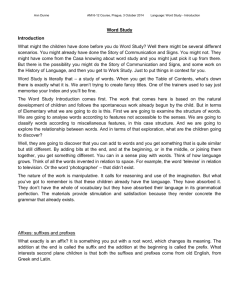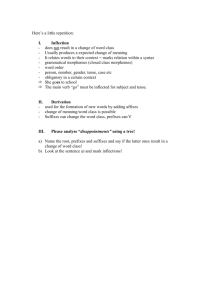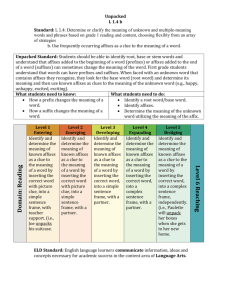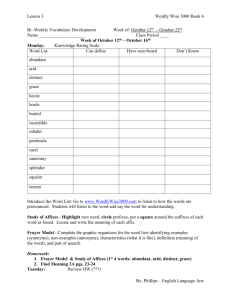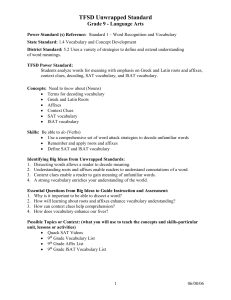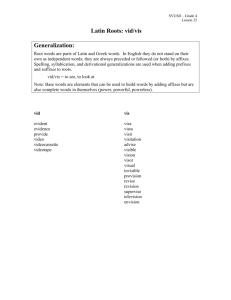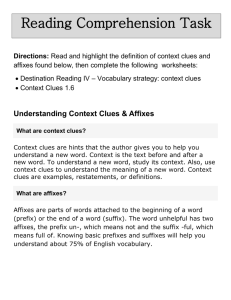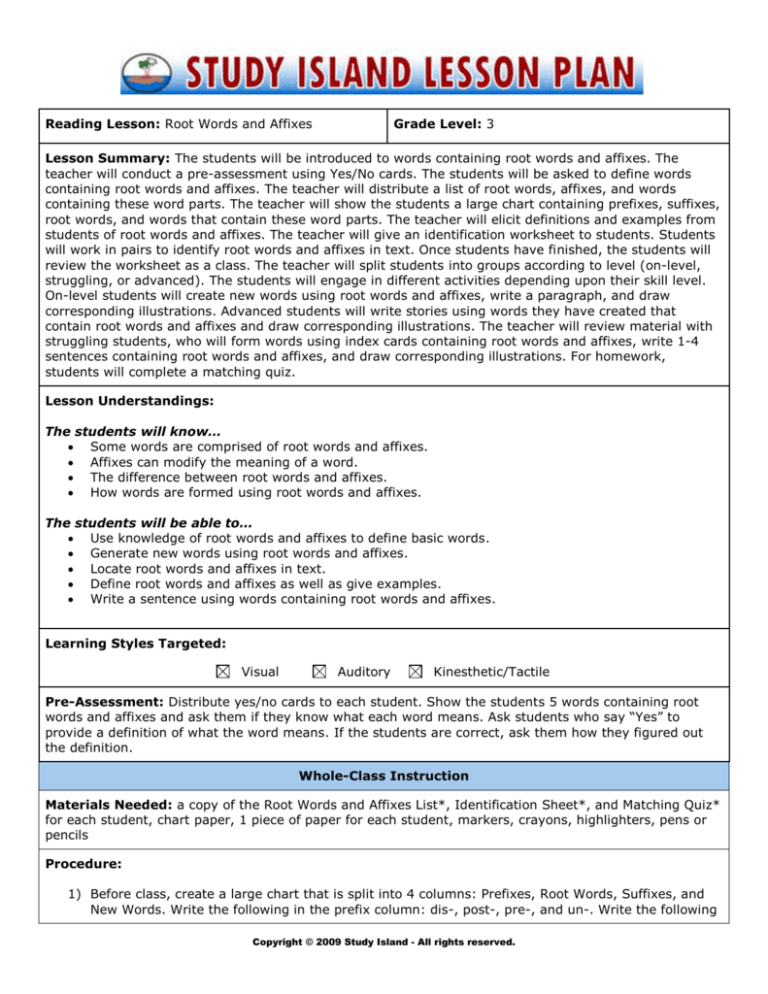
Reading Lesson: Root Words and Affixes
Grade Level: 3
Lesson Summary: The students will be introduced to words containing root words and affixes. The
teacher will conduct a pre-assessment using Yes/No cards. The students will be asked to define words
containing root words and affixes. The teacher will distribute a list of root words, affixes, and words
containing these word parts. The teacher will show the students a large chart containing prefixes, suffixes,
root words, and words that contain these word parts. The teacher will elicit definitions and examples from
students of root words and affixes. The teacher will give an identification worksheet to students. Students
will work in pairs to identify root words and affixes in text. Once students have finished, the students will
review the worksheet as a class. The teacher will split students into groups according to level (on-level,
struggling, or advanced). The students will engage in different activities depending upon their skill level.
On-level students will create new words using root words and affixes, write a paragraph, and draw
corresponding illustrations. Advanced students will write stories using words they have created that
contain root words and affixes and draw corresponding illustrations. The teacher will review material with
struggling students, who will form words using index cards containing root words and affixes, write 1-4
sentences containing root words and affixes, and draw corresponding illustrations. For homework,
students will complete a matching quiz.
Lesson Understandings:
The students will know…
Some words are comprised of root words and affixes.
Affixes can modify the meaning of a word.
The difference between root words and affixes.
How words are formed using root words and affixes.
The students will be able to…
Use knowledge of root words and affixes to define basic words.
Generate new words using root words and affixes.
Locate root words and affixes in text.
Define root words and affixes as well as give examples.
Write a sentence using words containing root words and affixes.
Learning Styles Targeted:
Visual
Auditory
Kinesthetic/Tactile
Pre-Assessment: Distribute yes/no cards to each student. Show the students 5 words containing root
words and affixes and ask them if they know what each word means. Ask students who say “Yes” to
provide a definition of what the word means. If the students are correct, ask them how they figured out
the definition.
Whole-Class Instruction
Materials Needed: a copy of the Root Words and Affixes List*, Identification Sheet*, and Matching Quiz*
for each student, chart paper, 1 piece of paper for each student, markers, crayons, highlighters, pens or
pencils
Procedure:
1) Before class, create a large chart that is split into 4 columns: Prefixes, Root Words, Suffixes, and
New Words. Write the following in the prefix column: dis-, post-, pre-, and un-. Write the following
Copyright © 2009 Study Island - All rights reserved.
in the root word column: happy, important, test, agree, sad, hope, and able. Write the following in
the suffix column: -ness, -less, -ful, and -ly. Write the following in the last column: disagree, posttest, pre-test, unimportant, disable, unhappy, unimportant, unable, happiness, sadness, hopeless,
and hopeful.
2) Distribute the Root Words and Affixes List (also contains words made on the word chart) to
students.
3) Define prefix, suffix, and root word for students. Show students an example of each from the chart.
Then, show students examples of “new words” found in the last column. Define each prefix and
suffix for the student. Have students write down the definitions of each example on his/her Root
Words and Affixes List. Give students additional prefixes (multi-, mis-, and non-) and suffixes (able, -ment, and –or) along with their definitions. Have students write down the new prefixes and
suffixes on their Root Words and Affixes Lists. Write the additional prefixes and suffixes on the
board after students have written them on their Root Words and Affixes Lists so students can check
their work.
4) Nominate students to come up to the board and write their own examples of prefixes, suffixes,
and/or root words.
5) Distribute the identification worksheet and ask students to work in pairs on highlighting root words
and underlining affixes. Monitor students. After the students have finished the activity, review the
worksheet as a class. Go over what the words containing root words and affixes mean.
6) Based on the students’ pre-assessments and your observations during teaching, break students
into groups according to level: struggling, on-level, and advanced.
7) For on-level students: Give each student a piece of paper. Ask students to write one paragraph (5
sentences) that uses at least 5 words with word parts. They may use words they have created and
words they have learned in class. Ask students to draw a picture for their paragraph. Recognize
students who do well on this assignment. For homework, distribute the matching quiz to each
student.
Advanced Learner
Materials Needed: notebook paper, writing utensils
Procedure:
1) Ask students to brainstorm in pairs or small groups (depending on number of students) and come
up with as many words containing root words and affixes as possible, along with definitions.
2) Have students write and illustrate a story that has at least 8 words containing root words and
affixes. Give out awards for the most creative story, highest number of root words and affixes, etc.
Struggling Learner
Materials Needed: index cards with a root word or affix written on the front of each one and definitions
written on the back of each one
Procedure:
1) Review the Root Words and Affixes List with students. Elicit definitions of root words and affixes
from students. Use the index cards as flash cards to quiz the students.
Copyright © 2009 Study Island - All rights reserved.
2) Review the identification sheet with students and make sure they have highlighted and underlined
the correct word parts.
3) Give students the root words and affixes index cards. Have students practice forming new words
using the index cards and write down the words they form. Ask students to write 1-4 sentences
using their newly formed words and draw a picture to go with their sentence(s). Give out awards
for most creative sentence, best illustration, etc.
* see supplemental resources
Copyright © 2009 Study Island - All rights reserved.

